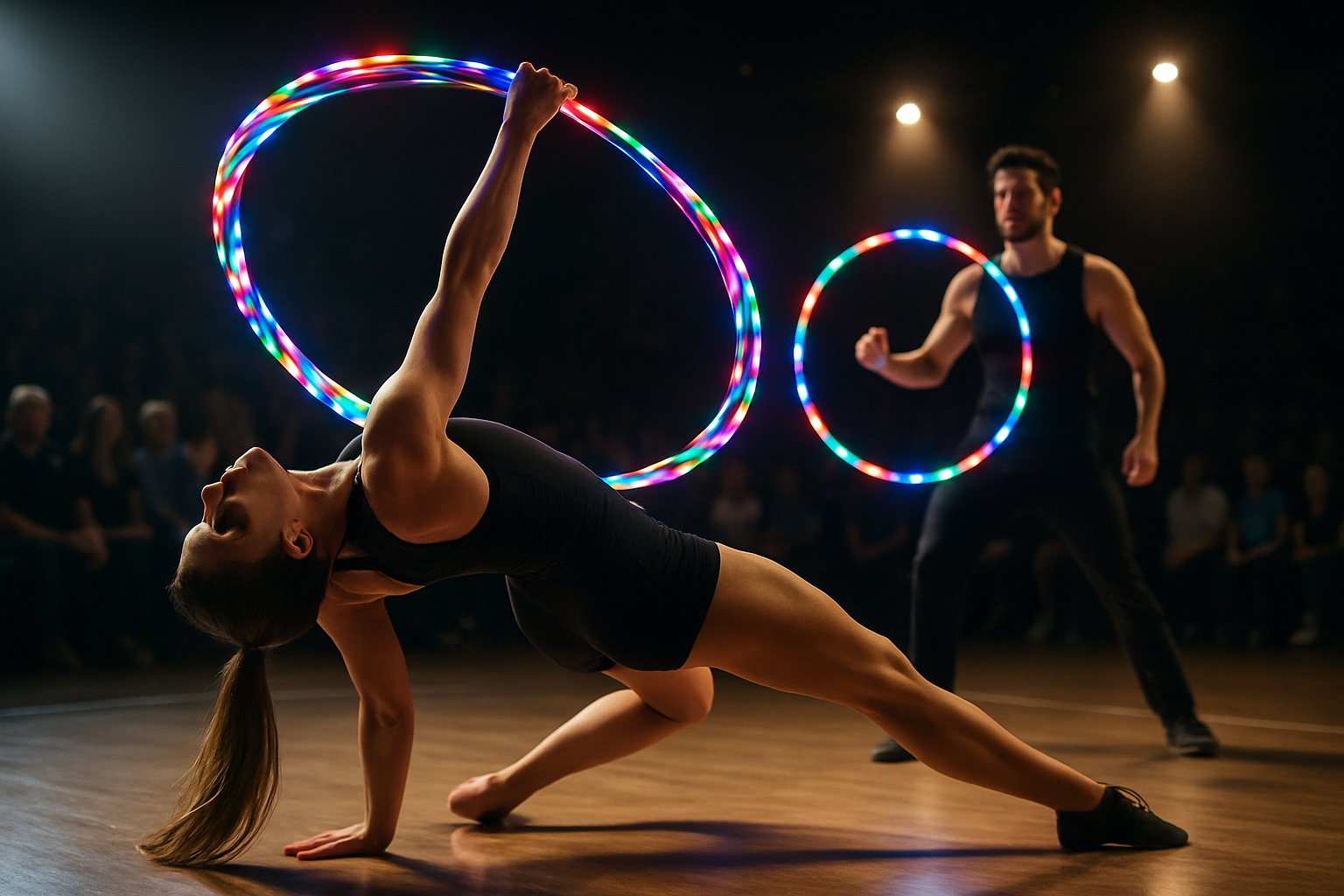Competitive Hula Hooping: The Rise of an Unconventional Sport
In a world where traditional sports often dominate headlines, a whimsical childhood pastime is spinning its way into the competitive arena. Competitive hula hooping, once relegated to playgrounds and circus acts, has emerged as a serious athletic pursuit, captivating audiences with its blend of artistry, athleticism, and sheer spectacle. This unlikely sport is challenging perceptions and redefining what it means to be an athlete in the 21st century.

As the internet facilitated connections between passionate hoopers worldwide, informal gatherings evolved into structured competitions. Pioneers of the sport developed increasingly complex routines, incorporating elements from dance, gymnastics, and circus arts. The World Hoop Day, first celebrated in 2007, played a crucial role in uniting the global hooping community and raising awareness of the sport’s potential.
The formation of the World Hoop Federation in 2013 marked a significant milestone, providing a governing body to standardize rules and organize international competitions. This formalization helped legitimize competitive hula hooping in the eyes of both participants and spectators, paving the way for its growth as a recognized sport.
The Art and Science of Competitive Hooping
Competitive hula hooping is far more than simply keeping a hoop spinning around one’s waist. Modern hoopers demonstrate extraordinary skill, strength, and creativity in their performances. Competitions typically feature multiple categories, each showcasing different aspects of hooping prowess.
Technical categories focus on precision and difficulty, with competitors executing complex sequences of moves such as isolations, where the hoop appears to float independently of the body, and multiples, where several hoops are manipulated simultaneously. Freestyle categories allow for more artistic expression, with hoopers choreographing routines set to music that blend dance, acrobatics, and hoop manipulation.
The physical demands of competitive hooping are considerable. Elite hoopers develop exceptional core strength, flexibility, and cardiovascular endurance. Training regimens often include cross-disciplinary elements, incorporating yoga, dance, and traditional strength training to build the well-rounded physicality required for top-level performance.
Equipment Evolution and Technological Advancements
As the sport has evolved, so too has the equipment. Modern competitive hoops bear little resemblance to their toy store counterparts. Professional-grade hoops are precisely engineered, with materials and designs optimized for specific styles of performance. Polypropylene tubing, once the standard, has given way to advanced composites that offer superior durability and responsiveness.
LED-embedded “smart hoops” have revolutionized the visual aspect of performances, allowing hoopers to create dazzling light shows synchronized with their movements. These technological marvels have opened up new avenues for creativity and spectacle in competitive routines.
Wearable technology has also found its place in the sport, with hoopers using fitness trackers and motion sensors to analyze and refine their techniques. This data-driven approach to training has contributed to the rapid advancement of skill levels within the competitive hooping community.
The Global Competitive Landscape
Competitive hula hooping has grown into a truly international sport, with major competitions held across the globe. The World Hoop Championships, first held in 2015, has become the premier event in the competitive hooping calendar, drawing top talent from over 30 countries.
Regional circuits have also flourished, with notable competitions in Europe, Asia, and the Americas providing opportunities for up-and-coming hoopers to showcase their skills. The European Hoop Championships, established in 2016, has been particularly influential in nurturing talent and pushing the boundaries of the sport.
The competitive structure typically includes divisions based on skill level and age, ensuring a pathway for progression from novice to elite status. Judging criteria have become increasingly sophisticated, with panels evaluating technical difficulty, execution, artistry, and overall impact of performances.
Challenges and Future Prospects
Despite its growth, competitive hula hooping faces several challenges on its path to wider recognition. The sport’s association with childhood play and circus performance can sometimes lead to skepticism about its legitimacy as an athletic pursuit. Educating the public and sports authorities about the skill and physical demands involved remains an ongoing task for the hooping community.
Funding and sponsorship opportunities are limited compared to more established sports, making it difficult for many competitive hoopers to pursue the sport full-time. However, innovative approaches to promotion, including social media showcases and collaborations with other performance arts, are helping to raise the sport’s profile and attract support.
The future of competitive hula hooping looks promising, with increasing interest from younger generations drawn to its blend of physical challenge and creative expression. Efforts are underway to standardize coaching certifications and develop youth programs, laying the groundwork for sustainable growth.
The Physical and Mental Benefits of Hooping
Beyond the competitive aspect, hula hooping offers a range of health benefits that contribute to its growing popularity as a fitness activity. The rhythmic nature of hooping provides an excellent cardiovascular workout, burning up to 400 calories per hour in intense sessions. The constant core engagement required to keep the hoop in motion leads to improved abdominal strength and posture.
Hooping also offers cognitive benefits, enhancing hand-eye coordination and spatial awareness. The meditative quality of maintaining a steady hoop rotation can reduce stress and improve mental focus, making it an attractive option for those seeking mindfulness in their exercise routines.
For competitive hoopers, the mental game is as crucial as physical preparation. Performers must develop strong concentration skills to execute complex routines flawlessly under pressure. The sport also fosters creativity and self-expression, allowing athletes to develop their unique style and artistic voice.
Breaking Stereotypes and Promoting Inclusivity
One of the most striking aspects of competitive hula hooping is its inclusivity. Unlike many traditional sports that favor specific body types or gender norms, hooping welcomes participants of all shapes, sizes, and backgrounds. This diversity is reflected in the demographics of top competitors, challenging conventional notions of what an athlete should look like.
The sport has been particularly empowering for women and non-binary individuals, who make up a significant portion of the competitive hooping community. Many cite the supportive and collaborative nature of the hooping world as a refreshing alternative to the often hyper-competitive atmosphere of other sports.
Efforts to increase accessibility have led to the development of adaptive hooping techniques for individuals with disabilities, further broadening the sport’s reach. Inclusive competitions and workshops have helped to showcase the universal appeal of hooping as both a recreational activity and a competitive pursuit.
The Role of Social Media in Popularizing the Sport
Social media platforms have played a crucial role in the growth and popularization of competitive hula hooping. Platforms like Instagram and TikTok have provided hoopers with a global stage to showcase their skills, connect with fellow enthusiasts, and attract new participants to the sport.
Short-form video content has proven particularly effective in capturing the dynamic and visually appealing nature of hooping. Viral clips of impressive tricks and routines have introduced millions to the sport, challenging preconceptions and sparking interest in both casual and competitive hooping.
Online communities have fostered a culture of skill-sharing and mutual support, accelerating the development of new techniques and styles. Virtual competitions and challenges have also emerged, allowing hoopers to participate in global events without the need for travel, further democratizing access to the competitive aspect of the sport.
The Intersection of Sport and Performance Art
Competitive hula hooping occupies a unique space at the intersection of sport and performance art. This duality presents both challenges and opportunities for the sport’s development and recognition.
On one hand, the artistic elements of hooping routines add a layer of subjective judging that can be contentious in competitive settings. Developing fair and consistent scoring systems that balance technical skill with artistic merit remains an ongoing challenge for organizers and judges.
Conversely, the performative aspect of competitive hooping opens up opportunities for crossover appeal. Collaborations with circus arts, dance companies, and music festivals have helped to expose new audiences to the sport. Some competitive hoopers have found success in entertainment industries, further raising the profile of hooping as a serious athletic pursuit.
The sport’s artistic nature also allows for a greater emphasis on individual expression compared to many traditional sports. This focus on creativity and personal style has been a key factor in attracting and retaining participants who may not have found their place in more conventional athletic activities.
Educational Initiatives and Youth Development
As competitive hula hooping continues to grow, there is an increasing focus on developing structured educational programs to nurture the next generation of hoopers. Schools and community centers in several countries have begun incorporating hooping into physical education curricula, recognizing its potential to engage students who may be less interested in traditional sports.
Youth hooping leagues are emerging, providing a pathway for young enthusiasts to develop their skills in a supportive, age-appropriate competitive environment. These programs often emphasize not just technical proficiency, but also creativity, teamwork, and personal growth.
Universities and colleges are also taking notice, with some institutions offering hula hooping as part of their recreational sports programs. A few forward-thinking schools have even begun to offer scholarships for competitive hoopers, acknowledging the unique skills and dedication required to excel in the sport.
The Economic Impact of Competitive Hooping
While still a niche sport, competitive hula hooping has begun to generate economic activity in various sectors. Specialized equipment manufacturers have emerged to meet the demand for high-quality performance hoops and accessories. These businesses often operate on a small scale, emphasizing craftsmanship and customization to cater to the specific needs of competitive hoopers.
Event organization has become another area of economic opportunity, with major competitions drawing participants and spectators from around the world. These events often incorporate workshops, vendor markets, and performances, creating mini-economies around the sport.
The growth of hooping as a fitness trend has also led to increased demand for certified instructors. Training programs and certification bodies have developed to meet this need, providing employment opportunities for experienced hoopers to share their skills in gym and studio settings.
Overcoming Stereotypes and Gaining Mainstream Recognition
Despite its growing popularity and the undeniable skill of its top practitioners, competitive hula hooping still faces challenges in gaining widespread recognition as a legitimate sport. The playful associations of the hoop and its history as a toy create perceptual barriers that the competitive hooping community continues to work to overcome.
Education and outreach efforts are crucial in this regard. Many top competitors and organizers dedicate time to public demonstrations and media appearances, showcasing the athleticism and artistry involved in high-level hooping. Documentaries and feature stories in mainstream sports media have helped to shift perceptions, highlighting the dedication and physical prowess required to compete at the elite level.
Efforts to align competitive hooping with established sports organizations are ongoing. While Olympic recognition remains a distant goal, inclusion in multi-sport events and recognition by national sports authorities are more immediate objectives for many in the hooping community.
The Impact of Competitive Hooping on Personal Development
For many participants, competitive hula hooping offers benefits that extend far beyond the realm of physical fitness and athletic achievement. The sport’s emphasis on creativity and self-expression can be profoundly empowering, particularly for individuals who may have struggled to find their niche in more traditional athletic pursuits.
Competitors often report increased self-confidence and improved body image as a result of their involvement in the sport. The supportive nature of the hooping community, with its emphasis on personal growth and mutual encouragement, provides a positive environment for developing social skills and building lasting friendships.
The discipline required to master complex hooping techniques translates well to other areas of life, with many hoopers citing improvements in focus, time management, and goal-setting abilities. For young participants, these skills can have a significant positive impact on academic performance and personal development.
Environmental Considerations and Sustainability
As competitive hula hooping grows, the community is increasingly conscious of its environmental impact. The production of hoops and related equipment, particularly those incorporating electronic components, raises questions of sustainability and responsible manufacturing.
Many hoop makers are responding to these concerns by exploring eco-friendly materials and production methods. Biodegradable plastics, recycled materials, and locally-sourced components are becoming more common in the industry. Some manufacturers have implemented take-back programs to ensure proper recycling or disposal of old or damaged hoops.
Event organizers are also taking steps to minimize the environmental footprint of competitions. Initiatives such as zero-waste policies, carbon offset programs for travel, and partnerships with local environmental organizations are becoming more prevalent in the competitive hooping world.
The Future of Competitive Hula Hooping
As competitive hula hooping enters its third decade as an organized sport, its trajectory continues to point upward. The combination of physical challenge, artistic expression, and inclusive community has proven to be a powerful draw for participants of all ages and backgrounds.
Technological advancements are likely to play a significant role in the sport’s future development. Innovations in hoop design, performance-tracking technology, and virtual reality training tools may open up new possibilities for skill development and competitive formats.
The sport’s global reach is expected to continue expanding, with emerging hooping communities in Africa, South America, and Southeast Asia poised to bring new perspectives and styles to the competitive arena. This geographical diversification may lead to the development of new competitive formats and judging criteria that reflect a broader range of cultural influences.
As awareness of the sport grows, increased media coverage and sponsorship opportunities are likely to follow. This could lead to the professionalization of competitive hooping, with more athletes able to pursue the sport full-time and higher-profile events attracting larger audiences.
Education and youth development will remain key focuses for the competitive hooping community. The establishment of structured training programs and the integration of hooping into physical education curricula could help to solidify the sport’s place in the broader athletic landscape.
Ultimately, the future of competitive hula hooping will be shaped by the passion and creativity of its practitioners. As the sport continues to evolve, it stands as a testament to the human capacity for finding joy, challenge, and community in unexpected places. From playground toy to global competitive arena, the hula hoop’s journey is far from over, and its next revolutions promise to be as surprising and inspiring as the last.





